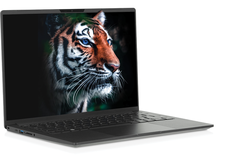A new slim-line laptop
The Next Generation

We test a new entrant in the world of slim and lightweight Linux-powered laptops.
Back in November 2020 [1], Linux Magazine tested the InfinityBook S 14 v5 from Tuxedo, a German laptop vendor that has been in the Linux business for more than 15 years. Despite a couple of minor gripes with the trackpad and power management, we were largely happy with the machine: It was light, slim, and had excellent battery life (14 hours on medium brightness, playing videos).
Now Tuxedo has a new laptop on offer, the InfinityBook Pro 14 Gen6 [2]. Tuxedo advertises the InfinityBook Pro as an "ultra portable business notebook," with particular marketing efforts focused on its display, magnesium-alloy chassis, and glass touchpad. The laptop is available in various configurations starting at EUR1160 (~$1,360), although the base price does not include a WiFi card. Our review unit checked in at EUR1349 (~$1,582), featuring the screen, chip, RAM, and storage specifications shown in Table 1.
Inside the box, you'll find the laptop along with a USB-C to RJ45 (Ethernet) adaptor, a WebFAI USB stick to restore the operating system (see "The Software Side" box), the power adaptor, and a tiny packet of Intel stickers (thankfully not glued onto the laptop by default). There's also a 40-page user guide and even a Tuxedo-branded paper notepad and pen as well.
[...]
Buy this article as PDF
(incl. VAT)
Buy Linux Magazine
Subscribe to our Linux Newsletters
Find Linux and Open Source Jobs
Subscribe to our ADMIN Newsletters
Support Our Work
Linux Magazine content is made possible with support from readers like you. Please consider contributing when you’ve found an article to be beneficial.

News
-
Parrot OS Switches to KDE Plasma Desktop
Yet another distro is making the move to the KDE Plasma desktop.
-
TUXEDO Announces Gemini 17
TUXEDO Computers has released the fourth generation of its Gemini laptop with plenty of updates.
-
Two New Distros Adopt Enlightenment
MX Moksha and AV Linux 25 join ranks with Bodhi Linux and embrace the Enlightenment desktop.
-
Solus Linux 4.8 Removes Python 2
Solus Linux 4.8 has been released with the latest Linux kernel, updated desktops, and a key removal.
-
Zorin OS 18 Hits over a Million Downloads
If you doubt Linux isn't gaining popularity, you only have to look at Zorin OS's download numbers.
-
TUXEDO Computers Scraps Snapdragon X1E-Based Laptop
Due to issues with a Snapdragon CPU, TUXEDO Computers has cancelled its plans to release a laptop based on this elite hardware.
-
Debian Unleashes Debian Libre Live
Debian Libre Live keeps your machine free of proprietary software.
-
Valve Announces Pending Release of Steam Machine
Shout it to the heavens: Steam Machine, powered by Linux, is set to arrive in 2026.
-
Happy Birthday, ADMIN Magazine!
ADMIN is celebrating its 15th anniversary with issue #90.
-
Another Linux Malware Discovered
Russian hackers use Hyper-V to hide malware within Linux virtual machines.

